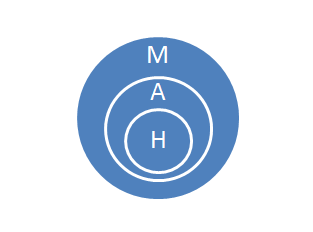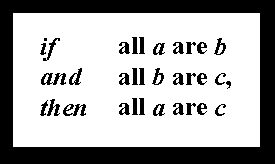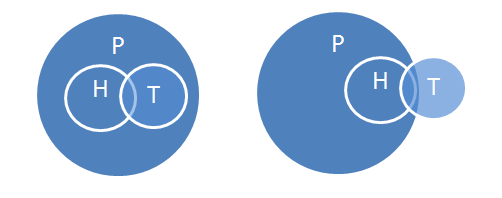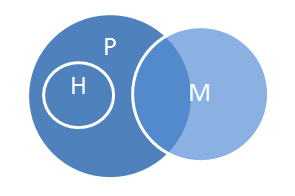In this article you will be given a tutorial on deductive reasoning and how to reason deductively. It is taken from one of i9’s IQ Prime ‘mindware’ tutorials.
Arguments
“What is an argument? Well, first it is necessary to say what an argument is not. An argument is not what you witness on talk shows and talk radio. Media will often bombard us with opinions and heart-felt emotions but we are seldom presented with arguments. No matter how loudly you state your opinion, no matter how sincerely you believe in your opinion, an opinion is not an argument. So what is an argument? An argument is a conclusion that is supported by a premise or premises. It may be helpful to imagine a roof supported by columns. Without the columns (the supporting premises) the roof (the conclusion) cannot stand. Arguments, like buildings, can be constructed properly and improperly. Like buildings that are constructed poorly, arguments that are built improperly will fall apart easily.”
We recognize the conclusions within an argument by words such as: ‘therefore’, ‘hence’, ‘thus’, ‘proving that’, ‘implying’. We recognize the premises within an argument with words such as: ‘for’, ‘because’, ‘in so far as’, ‘as supported by’.
Syllogistic reasoning and IQ
A study in this month’s edition of Intelligence has demonstrated with a large Japanese twin sample “a close association between syllogistic reasoning ability and general intelligence.” (Article reference here). Syllogistic reasoning is an important type of deductive reasoning, and deductive reasoning is a key fluid intelligence ability. Training deductive reasoning may be an effective method for helping increase IQ.
What is syllogistic reasoning and what is a syllogism?
Aristotle’s Syllogisms
This content builds on Glymour’s Thinking Things Through (Chapter 2) – an old colleague from Carnegie Mellon university.
Here is an example of a syllogism:
Syllogism 1
All humans are animals.
All animals are mortal.
Therefore, all humans are mortal.
A syllogism is a type of logical argument in which a pair of sentences serve as the premises and a third sentence serves as the conclusion. The example above is a valid syllogism. What makes it valid is that if the premises are true, then it follows necessarily that the conclusion is also true.
We can see how deductive arguments are valid by drawing circles. For Syllogism 1, let circle ‘H’ represent the set of all humans, circle ‘A’ represent the set of all animals, and circle ‘M’ represent the set of all mortal things. The first premise says the set of all men is contained in the set of all mortal things – so we can put circle H inside circle A to represent what would be needed for the first premise to be true.
Adding the second premise we get:
You can see from the diagram that necessarily H is inside M – which is what the conclusion asserts.
What makes a syllogism valid is that in any way you represent the two premises as true, the conclusion is true as well.
Here is another syllogism that has two possible diagrams for the premises.
Syllogism 2
All humans are primates.
Some humans have tattoos.
Therefore, some things with tattoos are primates.
Let H = the set of humans, P = the set of primates, and T = the set of things with tattoos.
Two possibilities are:
You can see that every way of representing the first two premises of the syllogism as both true has T intersecting H and H contained in P. And you can see that some T must be contained in P, which is what the conclusion asserts.
Here is an example of a syllogism that is not valid, and we can see this even though all the premises and the conclusion are true:
Syllogism 3
All humans are primates.
Some primates are mortal.
Therefore, all humans are mortal.
To see why this is not valid, we can find a way of arranging the circles in a way that the premises are true but the conclusion is false. The figure below represents a state of affairs that can be imagined in which all humans are primates, some primates are mortal, but all humans are immortal – the opposite of what the conclusion asserts.
In this invalid syllogism, the truth of the premises does not necessitate the truth of the conclusion.
The validity of a syllogism clearly does not imply that its premises are true or its conclusion is true. The validity of a syllogism doesn’t have anything to do with what the terms of the sentences mean. A valid syllogism could have true premises and a true conclusion or false premises and a true conclusion. But it cannot have true premises and a false conclusion! If the premises are true, the conclusion is necessarily true. This is what is meant by logical arguments being truth preserving. (For this reason, if you can find an example where the premises are true and the conclusion is false, you can show that a syllogism is invalid – see below.)
Syllogism Exercises
By giving an example in which the premises are clearly true and the conclusion is clearly false, show that each of the following syllogistic forms is invalid:
Syllogism 4
No A are B
All B are C
Therefore: No A are C
Syllogism 5
No A are B
All B are C
Therefore: Some A are C
Syllogism 6No A are B
all B are C
Therefore: Not all A are C
For more exercises click here.
Aristotle’s Theory of the Syllogism
In Aristotle’s theory there are four expressions (called quantifiers) that are prefixed to a subject-predicate phrase (‘A is B’). These are ‘all’, ‘no, ‘some’ and ‘not all’.
Stating that ‘not all A is B’ is logically equivalent to ‘Some A is not B’, so these 4 quantifiers can be represented as:
.
There are four ‘figures’ in syllogistic arguments. Note that the first premises have the terms A and B, all the second premises have the terms B and C, and all conclusions have the terms A and C.
There are 4 quantifiers that can attach to any of 3 sentences of each figure. Thus there are 4 x 4 x 4 = 64 distinct syllogistic forms for each figure. Since there are 4 figures there are 64 x 4 = 256 distinct forms of syllogistic arguments. Only some of these are valid. Most are invalid.
Here is a valid one that Aristotle identified (using Figure 3):
Syllogism 7
All B are A
Not all B are C
——————
Not all A are C
Syllogism Exercises
- By providing an example in which the premises are clearly true and the conclusion is clearly false, show that each of the following syllogistic forms is invalid.
No A are B No A are B No A are B
All B are C All B are C All B are C
————– —————– ——————
No A are C Some A are C Not all A are C
- Find two valid syllogisms for the 2nd figure.
Note: The following rules may also be helpful in trying to figure out if syllogistic arguments are valid or invalid:
Rule 1: From ‘No X are Y’ infer ‘No Y are X’.
Rule 2: From ‘All X are Y’ infer ‘Some X are Y’
Rule 3: From ‘Some X are Y’ infer ‘Some Y are X’
Syllogisms involving instances
Another logical principle is that from a universal claim one can infer an instance of it.
Thus
All men are mortal
Socrates is a man
———————–
Socrates is mortal
Or
What is spiritual is immortal.
The human soul is spiritual.
————————————
The human soul is immortal
Or
Whatever makes unions more democratic is good for unions
The open shop is something that makes unions more democratic
————————————————————————————-
The open shop is good for unions.
Propositional Syllogisms
A proposition is a whole sentence that can be true or false.
Modus Ponens
If P then Q
P
—————-
Q
(Sentences of the form ‘if…then…’ are called conditionals.)
Modus tollens
If P then Q
Not Q
—————–
Not P
Conditional Syllogisms (Chain Rule)
If P then Q
If Q then R
—————
If P then R
Disjunctive Syllogism
P or Q
Not Q
——–
P
Syllogism Exercises
Are these valid form of reasoning (try to find counter examples)?
If A is true, then B becomes more plausible.
B is plausible
———————————————————
Therefore, A becomes more plausible
If A is true then B is true
B is true
———————————
A is true




